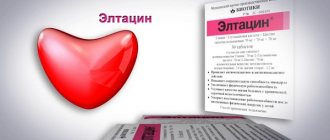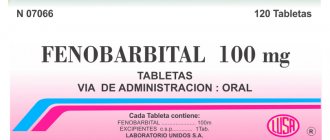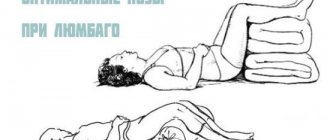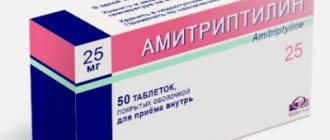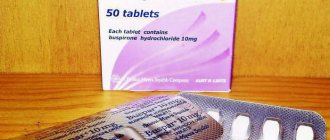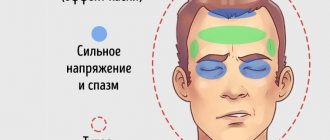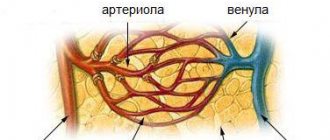Intercostal neuralgia is paroxysmal or periodic pain in the ribs due to muscle spasm.
Neuralgia is caused by compression and irritation of the roots of the intercostal nerves in the area of their exit from the spinal column. Injections for intercostal neuralgia can alleviate the neurological symptoms of the disease, relieve inflammation and reduce severe pain.
Treatment with injections
Compression of the nerve roots can be caused by osteochondrosis , muscle injuries, colds, stomach disease and neurological diseases. Pain with intercostal neuralgia can be acute, aching or dull, accompanied by muscle twitching, severe tingling in the chest, sweating, and discoloration of the skin.
Injections with painkillers for intercostal neuralgia help relieve severe muscle spasm, inflammation and pain before treating the underlying disease.
Tablets for intercostal neuralgia
Intercostal neuralgia is a pain syndrome that occurs as a result of irritation or compression of the nerves located between the ribs.
Tablets for intercostal neuralgia are the main part of the complex treatment of this disease. The following medications are used during therapy:
- analgesics (painkillers) are sedalgin, analgin, and also spasgan. This group of drugs removes the main symptom of the disease – pain. Such tablets are taken in a dosage 3-4 times a day. You should not take them more often - this will not give results, on the contrary, side effects may appear;
- non-steroidal anti-inflammatory tablets - voltaren and diclofenac, indomethacin, piroxicam, and ibuprofen. They remove inflammation and can relieve painful spasms a little. These medications are taken 1-2 times a day. Increasing the dosage may lead to an increased risk of gastrointestinal pathology. Without a doctor's prescription, medications in this group are allowed to be taken for a maximum of 5-7 days;
- muscle relaxants are effective tablets for neuralgia. They are designed to remove muscle spasms, which are one of the factors in the appearance of intercostal neuralgia. This group of drugs includes clonazepam, baclofen, and sirdalud. The doctor selects the duration of taking the pills individually.
Advantages and disadvantages
Advantages:
- The speed of action of the drug due to its direct delivery to the affected area.
- The effectiveness of the medicine, because it is not absorbed in the gastrointestinal tract and liver.
- Duration of action of drugs when used in the form of a suspension or oil solution.
Flaws:
- Pain and swelling at the injection site.
- Possibility of infection at the injection site.
- Injections are quite complex in their preparation and administration.
Pain Relief Guide
Answers to the most common questions that arise from patients and their loved ones when prescribing strong analgesics
We present a fragment of a brochure for doctors “Pain management in palliative care. A practical guide for a doctor", prepared by the Vera charity foundation. The full version of the brochure is available for download here.
What are weak and strong opioid analgesics? Weak opioids are used to treat moderate pain and in patients with a long life expectancy. The main weak opioid analgesic is tramadol.
If tramadol is intolerant, or when its maximum daily dose does not relieve pain, it is necessary to take strong opioid analgesics. Strong opioid analgesics are morphine and morphine-like painkillers (prosidol, targin, fentanyl, etc.). Morphine blocks pain signals in the spinal cord and brain.
Other strong opioids are commonly prescribed for people intolerant to morphine and for those who have difficulty taking pills (transdermal systems).
Why was I prescribed morphine or other strong opioid analgesics? In most cases, if you are prescribed morphine or other strong opioid analgesics, it is because other pain medications do not relieve your pain.
You may have previously taken paracetamol or other NSAIDs (such as ibuprofen) or weak opioids (tramadol). They do not always provide sufficient pain relief. If your pain is very severe, your doctor may immediately prescribe strong opioids.
I was prescribed morphine. Does this mean I'm dying? Just because you have been prescribed morphine does not mean that you are close to death.
Some patients (usually cancer patients) take opioids for months or even years, while others do not need it at all. Opioids provide more freedom: patients sleep better and feel less pain when they move.
Appetite may return, and not only to food, but to life in general.
Do opioid analgesics completely relieve pain? Usually yes, but sometimes they cannot completely relieve pain, especially some types of pain: bone pain, neuralgia or pain caused by bedsores. In this case, other treatment may be needed.
For example, treating bone pain caused by cancer often requires NSAIDs along with strong painkillers. And some types of pain, such as tension headaches, migraines, muscle spasms and cramps, are not treated at all with opioid analgesics.
Your doctor will definitely recommend the appropriate treatment for you.
Why do some people need more opioids than others? There may be many reasons, including:
- differences in pain severity;
- differences in how your body reacts to pain;
- the cause of the pain (opioids do not relieve different types of pain equally well);
- differences in how the body resists opioids;
- use of other pain relievers and non-drug treatments;
- differences in symptoms.
Is it better to postpone opioid analgesics until the pain becomes unbearable? You are concerned that your body may become accustomed to morphine and if this happens, there will be nothing to relieve the pain. If the pain returns while you are taking morphine (or another opioid), your doctor or nurse will increase your dose to relieve the pain (this can be done more than once if necessary).
Will I have to keep increasing the dose to control the pain? Not necessary. Many people stay on low or medium doses throughout their illness. Sometimes it is possible to reduce the dose or stop taking opioid analgesics altogether. But this should always be done under the supervision of a doctor.
How long do I need to take opioids? Does the effect weaken over time? You can take opioid analgesics for the rest of your life, whether it's months or years. Usually the effect does not subside. If you need to increase your dose, it is usually because your condition is causing more pain, not because the effects of the opioids are wearing off.
Will I become dependent on opioid analgesics? If you mean, “Will I become addicted to this substance and be unable to quit even when I no longer need it for pain relief?”, the answer is a clear NO.
Addiction is very rare when strong opioids are taken to relieve pain, and you don't have to worry about that.
On the other hand, if you have previously abused substances similar to morphine (such as heroin), you may have difficulty reducing your opioid dose.
If you no longer need to take opioid analgesics, it is best to gradually reduce your dose under your doctor's supervision. The reason is that people who take opioids for several months and then suddenly stop develop withdrawal symptoms, which include general malaise and diarrhea. But the dose needed to prevent withdrawal symptoms is much lower than the dose for pain relief.
Source: //cpmdzm.moscow/patients/gid-po-obezbolivaniu/
NSAIDs
Injections of non-steroidal anti-inflammatory drugs help reduce fever and pain due to intercostal neuralgia:
Diclofenac . Highly effective anti-inflammatory and analgesic agent. Reduces pain and swelling in joints, increases their mobility. Contraindications: urticaria, pregnancy, breastfeeding, childhood, asthma, hypersensitivity to NSAIDs. Cost: solution for 25 mg/ml 3 ml – 210 rub./pack.
Meloxicam . Analgesic, anti-inflammatory and antipyretic agent. Contraindications – gastrointestinal ulcers, problems with the liver, kidneys, pregnancy, childhood, hypersensitivity to NSAIDs. Cost: solution for 10 mg/ml 1.5 ml – 220 rub./pack
Pentalgin for neuralgia
The treatment tactics for neuralgia primarily depend on the cause that caused this condition. Therefore, for timely diagnosis and selection of therapy, you should consult a doctor. However, to quickly provide first aid to yourself, you can use the painkiller for neuralgia Pentalgin. This is a modern analgesic that has a complex effect, influencing several mechanisms of pain formation.
The drug contains 5 active components (paracetamol, drotaverine, naproxen, pheniramine and caffeine), which act together and complement each other for more effective pain relief.
Naproxen is a non-steroidal anti-inflammatory drug and reduces inflammation, swelling and pain at the site of injury or inflammation. Due to prolonged elimination from the body, naproxen has a long-lasting analgesic and anti-inflammatory effect.1-3
Paracetamol is a central analgesic, i.e. it affects the perception of pain in the brain, and also participates in the functioning of the so-called antinociceptive system of our body - a special system whose work is aimed at suppressing pain
An important feature of paracetamol is the rapid development of analgesic action - usually within half an hour after taking the drug.4,5
Drotaverine is widely used in clinical practice due to its pronounced antispasmodic effect - by relieving spasms in smooth muscles, it also helps eliminate pain caused by spasms.
The inclusion of caffeine and pheniramine in the combination drug is due to their ability to enhance the analgesic effect of analgesics, which makes it possible to reduce the dose of individual components and thus reduce the risk of a number of side effects.
Thanks to a carefully thought-out composition that ensures the drug’s effect on several mechanisms of pain formation at once, Pentalgin can help with neuralgia of various origins. In addition, the tablets have an antipyretic effect, and therefore this remedy can provide double help for inflammatory diseases accompanied by neuralgic pain and hyperthermia (increased body temperature).
Muscle relaxants
In cases of severe pain, muscle relaxants are used to relieve muscle spasms:
Myoflex . Eliminates muscle pain caused by spasm. Contraindications: muscle hypotension, hypersensitivity to the drug. Cost: d/i solution IM 10 mg/ml 1.5 ml – 250 RUR/pack.
Sirdalud .
Eliminates painful spasms with increased skeletal muscle tone. Contraindications: pregnancy, breastfeeding, childhood, hypersensitivity to the drug. Cost: solution for 10 mg/ml 1.5 ml – 315 RUR/pack. Article on the topic: Find out all the symptoms of cervicothoracic osteochondrosis
Steroid hormones
Hormones with a pronounced anti-inflammatory effect are prescribed for intense pain:
Triamcinolone . Anti-inflammatory, immunosuppressive, antiallergic agent. Contraindications – diseases of the nervous system, gastrointestinal ulcers, high blood pressure, osteoporosis, diabetes, skin infections. Contraindicated for kidney disease. Cost: susp. d/i 40 mg/ml 1 ml – 450 rub./pack.
Betamethasone . Anti-inflammatory, antiallergic, antipruritic agent. Contraindications – gastrointestinal ulcer, hypertension, diabetes mellitus, osteoporosis, mental disorders, bleeding, hypersensitivity to the drug. Cost: solution for 10 mg/ml 1 ml – 85 rub./pack.
Multivitamins
Multivitamins are preparations that include vitamins and microelements that support the immune system:
Combilipen . Eliminates inflammatory and degenerative diseases of the nervous system and joints. Contraindications – heart failure, pregnancy, breastfeeding, childhood, hypersensitivity to the drug. Cost: d/i solution 2 ml – 215 RUR/pack.
Milgamma Compositum . Improves blood circulation in tissues, conduction of nerve impulses, and has an analgesic effect. Contraindications – heart disease, fructose intolerance, childhood, pregnancy, breastfeeding, hypersensitivity to the drug. Cost: d/i solution 2 ml – 750 RUR/pack.
Painkillers
If intercostal neuralgia causes symptoms of neurological failure, intramuscular injections of painkillers are prescribed:
Ketonal . Antipyretic, analgesic and anti-inflammatory agent. Contraindications – gastrointestinal ulcers, kidney, liver and heart diseases, bleeding in the gastrointestinal tract, asthma, pregnancy, breastfeeding, childhood, hypersensitivity to the drug. Cost: solution for 50 mg/ml 2 ml – 730 rub./pack.
Analgin . Analgesic, anti-inflammatory and antipyretic agent. Contraindications – diseases of the blood, liver, kidneys, hypersensitivity to the drug. Cost: solution for 25% 2 ml – 35 RUR/pack.
Features of pain with neuralgia
Pain with intercostal neuralgia occurs due to irritation of the endings of nerve fibers located in the thoracic spine. The occurrence of this sign of pathology must be taken seriously, as it may indicate the presence of more dangerous diseases, in particular, such as pneumonia or heart attack.
To distinguish a symptom and determine which part of the body is affected, several tests must be performed. Since the spinal column is involved in movement, if the nerve endings are pinched during movement, the pain will intensify. With neuralgia, almost unbearable pain usually occurs, limiting movement. When trying to straighten up, the painful sensations only intensify, forcing the patient to remain in a half-bent position. In addition, painful sensations also occur when taking a deep breath. Many patients note that before an attack, their back begins to hurt in the area of the shoulder blades.
With neuralgia, pain often occurs only on one side and lasts for several minutes, and residual symptoms remain for a long time. Sometimes painful sensations can occur in the area of the heart, which causes great anxiety in patients. In addition, there may be paroxysmal pain in the abdomen, it all depends on the location of the damaged nerve.
If the pain occurs due to the presence of diseases of the cardiovascular system, then it will not intensify with movement, but only with exercise. If there are pathologies of the lungs, then the pain will not change in any way when changing position, and much more often it is observed when changing position. With neuralgia, characteristic signs may be:
- attack of chest pain;
- breath stops;
- pain literally permeates the entire body.
Attacks of pain are repeated very often, but in the short intervals between attacks the patient is completely undisturbed. Often there may be discomfort in the spine area. The duration of such attacks is several seconds or in severe cases even hours.
Vitamins
Vitamins B1, B6 and B12 restore damaged myelin sheath of nerve fibers:
Milgamma . Eliminates degenerative and inflammatory diseases of joints, nervous and muscle tissue. Contraindications – heart disease, pregnancy, breastfeeding, childhood, hypersensitivity to the drug. Cost: solution for 2 ml – 850 rub./pack.
Nerviplex . Eliminates neurological disorders caused by deficiency of B vitamins. Contraindications – optic nerve atrophy, pregnancy, breastfeeding, hypersensitivity to the drug. Cost: size d/in. amp. 2 ml – 178 RUR/pack.
Chondoprotectors
Chondroitin sulfateMukosat (5 amp. 250-500 rub.), Chondrogard (10 amp. 600 rub.), Chondrolon (10 amp. 800-1100 rub.), Artradol (10 amp. 700 rub.) Chondroitin sulfate - this drug is an anti-inflammatory drug, which is prescribed for the treatment of diseases of the joints and spine. It slows down bone tissue resorption, improves calcium-phosphorus metabolism in cartilage tissue, stops the destruction of connective and cartilaginous tissue, and accelerates recovery processes. Reduces pain and increases mobility of the spine and joints. It is structurally similar to heparin, and therefore prevents the formation of blood clots in the subchondral and synovial beds. |
Immunostimulants
Intercostal neuralgia can be caused by viral diseases. In this case, therapy is carried out with drugs that increase immunity:
Timalin . Stimulates the growth of lymphocytes, strengthens the immune system. Contraindications: pregnancy, asthma, hypersensitivity to the drug. Cost: liof. for standard solution 10 mg – 440 RUR/pack.
Cycloferon .
Effective against viral and bacterial infections, prevents tumor growth. Contraindications: liver cirrhosis, pregnancy, breastfeeding, age under 4 years, hypersensitivity to the drug. Cost: solution for 12.5% 2 ml – 357 RUR/pack. Article on the topic: Why pain occurs in the right and left hypochondrium and radiates to the back
Signs of the disease
Painful sensations with intercostal neuralgia can occur suddenly or be provoked by turning the body, bending to the side, and even deep breathing.
Characterized by acute pain spreading along the intercostal spaces. The intensity of pain is sometimes so high that it makes a person freeze and not move to wait out this attack, since any movement increases the discomfort.
Pain can occur in any part of the chest. Often the epicenter of pain is located behind the sternum and in the left half of the chest, which is sometimes misleading and leads to a false conclusion about the presence of heart disease (read how to distinguish here). With neuralgia of the lower intercostal nerves, the pain syndrome can resemble renal or hepatic colic and imitate other diseases of the abdominal cavity.
The main difference between intercostal neuralgia and other types of chest pain is the pain in the intercostal spaces when pressing on them with your fingers.
In the absence of a qualified examination, intercostal neuralgia may be mistaken for another disease. For this reason, if chest pain occurs, you should not self-medicate. To make a diagnosis and prescribe adequate treatment for intercostal neuralgia, you must consult a doctor.
Other medicines
To treat inflammation and pain associated with intercostal neuralgia, medications are used in various forms:
Voltaren in the form of a patch. It has a rapid anti-inflammatory and analgesic effect and can be used throughout the entire treatment. Contraindications: skin diseases. Cost: 15 mg/day – 346 RUR/pack.
Movalis tablets. An anti-inflammatory and analgesic drug, used as an additional therapy. Contraindications – gastrointestinal ulcer, kidney, liver, heart disease, pregnancy, breastfeeding, age under 12 years, hypersensitivity to the drug. Cost: TB 15 mg – 734 rubles.
Danger of disease
The cause of the disease is compression of the nerve roots that pass between the ribs, or their severe irritation. Intercostal neuralgia manifests itself as severe pain, which becomes more intense with a deep sigh, coughing, sudden movements - bending and turning the body. The disease is a number of serious ones that have a lot of unpleasant consequences, so timely diagnosis and treatment should be carried out by an experienced doctor. This is explained by the fact that in terms of external signs and manifestations, intercostal neuralgia is similar to diseases such as renal colic or pathologies of the cardiovascular system. In order for the patient to quickly get rid of the symptoms of the disease and return to a normal, full-fledged lifestyle, the doctor will select the most appropriate drug treatment based on the general picture of the disease, the results of an X-ray examination, laboratory tests and the overall picture of the disease.
There is no need to say once again that self-medication is unacceptable, because under the mask of intercostal neuralgia the symptoms of other, more dangerous diseases can be hidden, and self-administered medications can give various side effects (if the dosage is incorrectly calculated or if there is a tendency to exhibit allergic reactions to the components of the drugs ).
In the first days of the disease, the patient, in addition to urgently consulting a doctor, can be advised to rest completely, refrain from work, and sleep on a hard and level surface, with the exception of high pillows.
Rules for injections
Injections for intercostal neuralgia are given to an area with a well-developed muscle layer , where there are no trunks of nerve endings and large blood vessels. The medicine is heated to a temperature of 30-37 degrees Celsius.
The hands of the person conducting the procedure are disinfected and rubber gloves are put on.
The patient should take a lying position on his stomach with his arms extended upward. The desired injection site is treated with ethyl alcohol.
The syringe is installed at an angle of 70 degrees, the needle is inserted into the muscle approximately 2/3 of the way. The plunger of the syringe is pulled back to ensure that the needle does not enter a blood vessel, and the medicine is smoothly injected into the muscle. The injection site is treated with an antiseptic.
Very rarely, injections using injections for intercostal neuralgia can cause pneumothorax of the lung , manifested by a symptom of shortness of breath and requiring immediate consultation with a therapist. In this regard, drug treatment of intercostal neuralgia should be carried out under the strict supervision of the attending physician.
Brachial neuralgia
Neuralgia of the shoulder develops when the nerve endings in the joint area are pinched. The reasons may be different: overload, hypothermia, injury and the development of cartilage diseases. For treatment, tablets are used that relieve pain and help get rid of inflammation. Additionally, medications are combined with physiotherapeutic treatment.
The main means, as in the treatment of any other type of neuralgia, are NSAIDs, tablets relieve pain and help with inflammation. Prescribe iubprofen or diclofenac. If the patient finds it difficult to endure pain and the pills do not help, they resort to injections - novocaine or lidocaine blockades.
The use of tablets for neuralgia is based on a prescription and doctor’s testimony. Taking medications at the slightest pain is not the best choice for the patient, since analgesics can hide important symptoms and complicate diagnosis.
As for the prevention of a disease that occurs constantly, doctors recommend normalizing your lifestyle. This means that you need to eat right, remove the abundance of fats and refined foods from the menu, and also include moderate physical activity and walks. People with neuralgia are not recommended to be exposed to severe stress.
Other treatments
Home methods can also reduce pain and inflammation :
- Rubbing the sore spot with Vaseline and turpentine.
- Compresses made from a mixture of turmeric, ginger and chili pepper.
- Rubbing glycerin and iodine into the sore spot, as well as lilac-based ointments.
Another type of home therapy involves taking warm medicinal baths for 10-15 minutes before bed.
For baths, you can use a decoction of aspen bark and poplar branches, as well as a tincture of sage, eucalyptus and lavender oils. We recommend watching the following video

